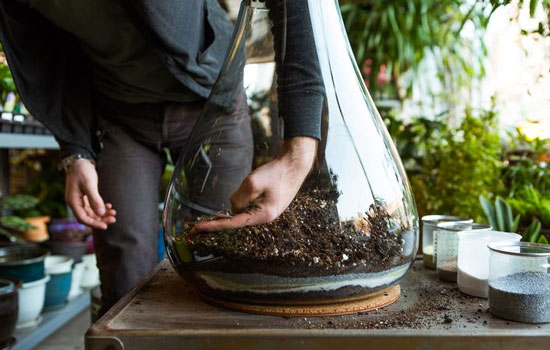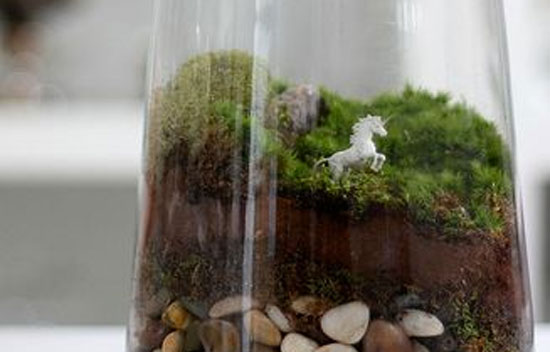
Combining equal parts good looks and whimsy, a terrarium allows you to bring a miniature world into your home.
There are many different types of terrariums you can create, from succulent-studded landscapes, to hanging orbs with air plants, to beautiful mossariums, or a challenging Marimo Terrarium (or Japanese moss ball aquarium).
That’s precisely why they’re so popular – they’re a enchanting escape from the everyday.
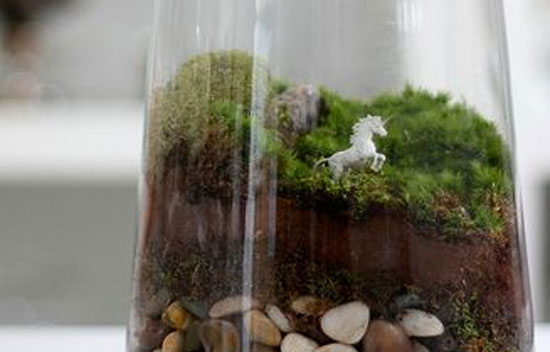
But the classic, enclosed terrarium – that retro fave of the 70s – is surprisingly simple to make and maintain.
Here’s how to make your own garden behind glass…
What you’ll need
- Miniature plants
- Activated charcoal (available from pet shops and nurseries)
- Potting mix (preferably containing a small ratio of sand)
- Decorative pebbles, gravel or sand
- Sphagnum/sheet moss or a coffee filter
- A spray bottle
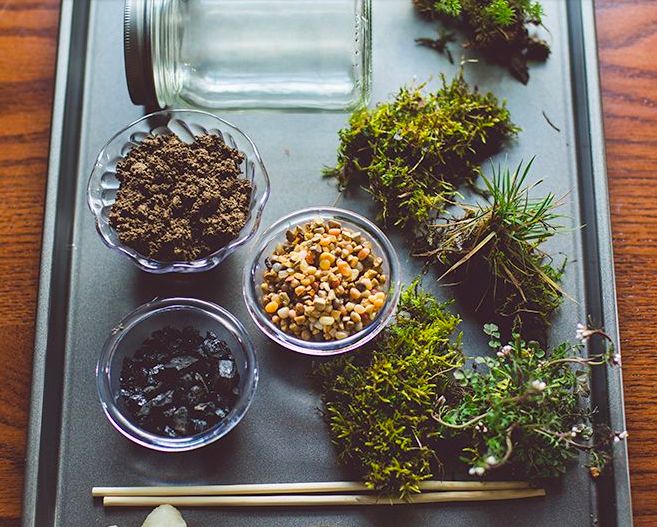
… and of course, a glass vessel with a lid.
Old bottles, mason jars, bell jars (or glass cloche), apothecary jars and aquariums are all suitable. You can find them at homewares and vintage stores.
Read more: Save cash by buying second-hand
Selecting the right plants
It’s best to choose plants that are both slow growing and enjoy a bit of humidity. Plant smart and combine those that appreciate similar light conditions.
Combine plants that like similar light conditions.
Make sure you inspect your plants thoroughly before use for any signs of disease or insects (because there’s nothing worse than a terrarium overrun with creepy crawlies).
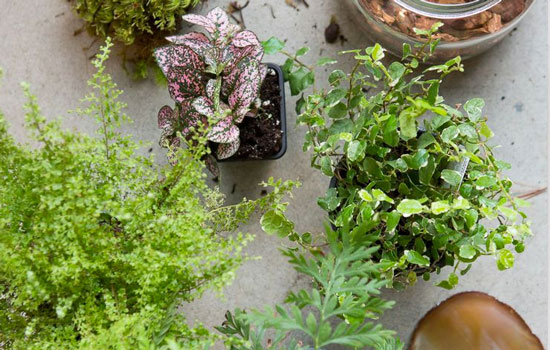
Here’s a few planting suggestions: Peperomia (Emerald Ripple) Begonia Rex, Syngonium (Sunshine Speckles), Fittonia (Mosaic plant), most ferns, Club Moss, and ‘Baby’s Tears’.
Read more: 9 steps to make a desert terrarium using succulents & cacti
Building a verdant foundation
Your planting mix should consist of four layers.
- The bottom layer is for drainage
Pour a decent amount of stones into your container. The smaller the vessel, the thinner the rock layer should be to allow for soil and plant growth. - The second layer is for hygiene
This requires a thin layer of activated charcoal. It helps prevent mould and will aerate the soil. - The third layer is to prevent soil from settling at the bottom
Spread a thin cover of sphagnum moss or use an organic coffee filter over the charcoal to create a barrier between the two. - The final layer is your growing medium
Pre-moisten your soil but do not saturate. Use a spoon or a paper funnel to pour it in carefully. Feel free to get creative at this point, adding hills and valleys. Pat the soil down firmly before adding plants.
Create a magical arrangement
Now for the fun part.
You want your terrarium to look good from all angles, so displaying your plants architecturally is the way to go.
Make holes in the soil big enough for the roots of your plants and nestle them in firmly.
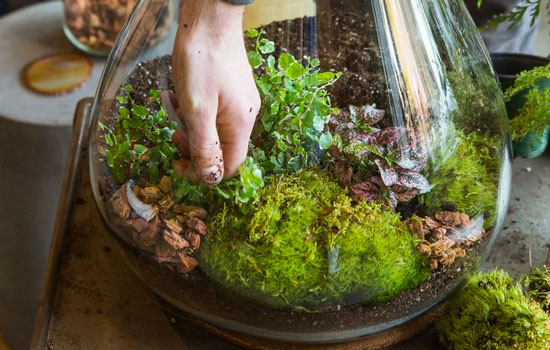
Place the tallest in the centre or rear and arrange the smaller ones around it. Think about placing contrasting colours alongside each other for greater effect.
Place plants of contrasting colours alongside each other for visual impact.
Once you’ve laid out all the plant elements, add moss, stones, twigs or bark to fill out the landscape.
If you’re feeling brave, try creating a story around all the elements by adding tiny mushrooms, animals or other figurines – accents like this can really bring a terrarium to life.
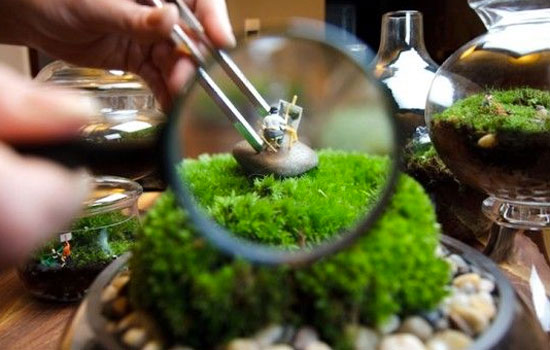
Monitor the plants carefully over the next few days. If they appear to wilt, just mist with water.
Top tip: Terrariums that embrace a wild, natural look are easier to maintain than one that’s ordered and controlled.
Read more: 5 things that can be used in home upcycling projects
Caring for your terrarium
Here’s the good news: it’s easy.
The principle behind a terrarium is that it mimics nature’s own life cycle: the lid allows water to recycle itself, organic matter to be reused as plant food, and helps it to maintain its humidity.
An enclosed terrarium mimics nature’s own life cycle.
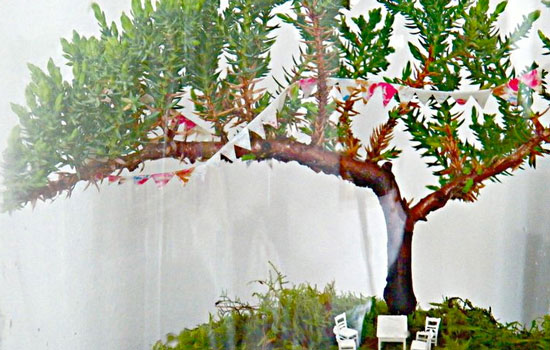
When all the elements come together, an enclosed terrarium requires very little maintenance apart from the odd prune or idle mist of water.
Lighting
Enclosed terrarium plants enjoy diffused or indirect light. If your plants look like they’re struggling, try a fluorescent globe or alternate your terrarium’s location from time to time. Avoid direct sun (unless you want to induce a kind of global warming).
Watering
It’s important not to over-water as this can lead to rot or fungus. Condensation is a good sign – it means your plants are breathing. But if you’re concerned, leave the lid off for a little while, just not so long that it all dries out. Once the right humidity is established, a closed terrarium can go a month or more between watering.
They actually thrive on neglect!
Condensation is a good sign – it means your plants are breathing.
Cleaning
If you feel the need to clean, just use paper towel or cotton bud.
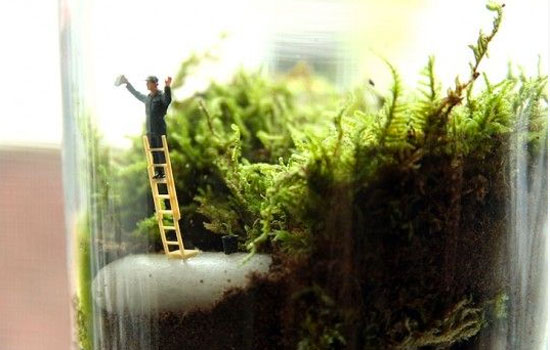
Pruning
As the nutrients in the soil get used up, your plants’ growth will slow down. A little trim will bring them into bounds but can also promote side shoots. If you want to keep things ordered, remove all the vegetation that you cut. A self-sustaining terrarium is happiest growing wild.
Find more terrarium & house plant inspiration on our Pinterest page.
Images sourced from Pinterest.
Follow us on Twitter for more news, tips and inspiration. Become our mate on Facebook and explore our Pinterest boards.
Like this article or found it helpful? Share it!
